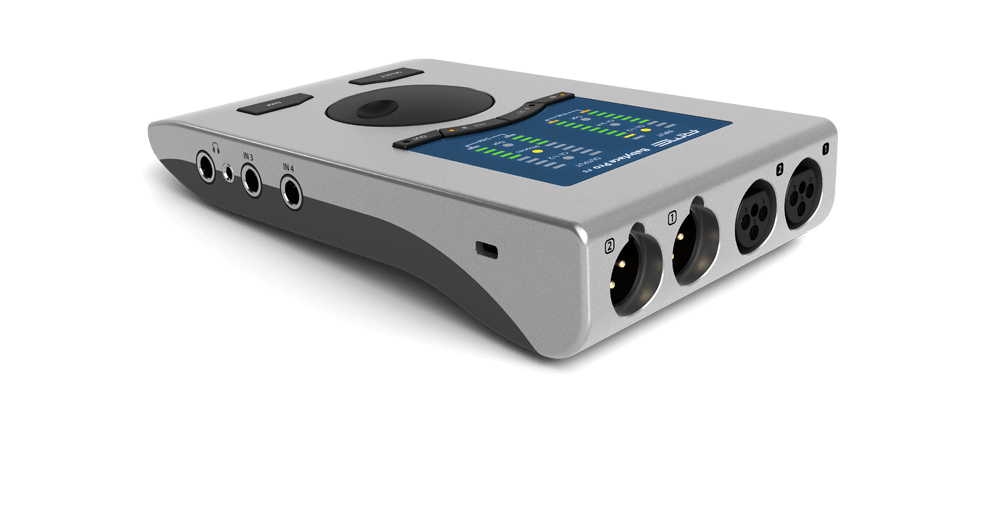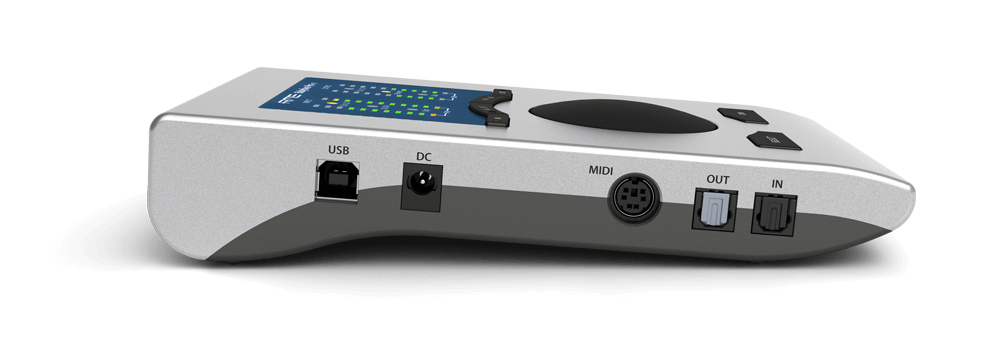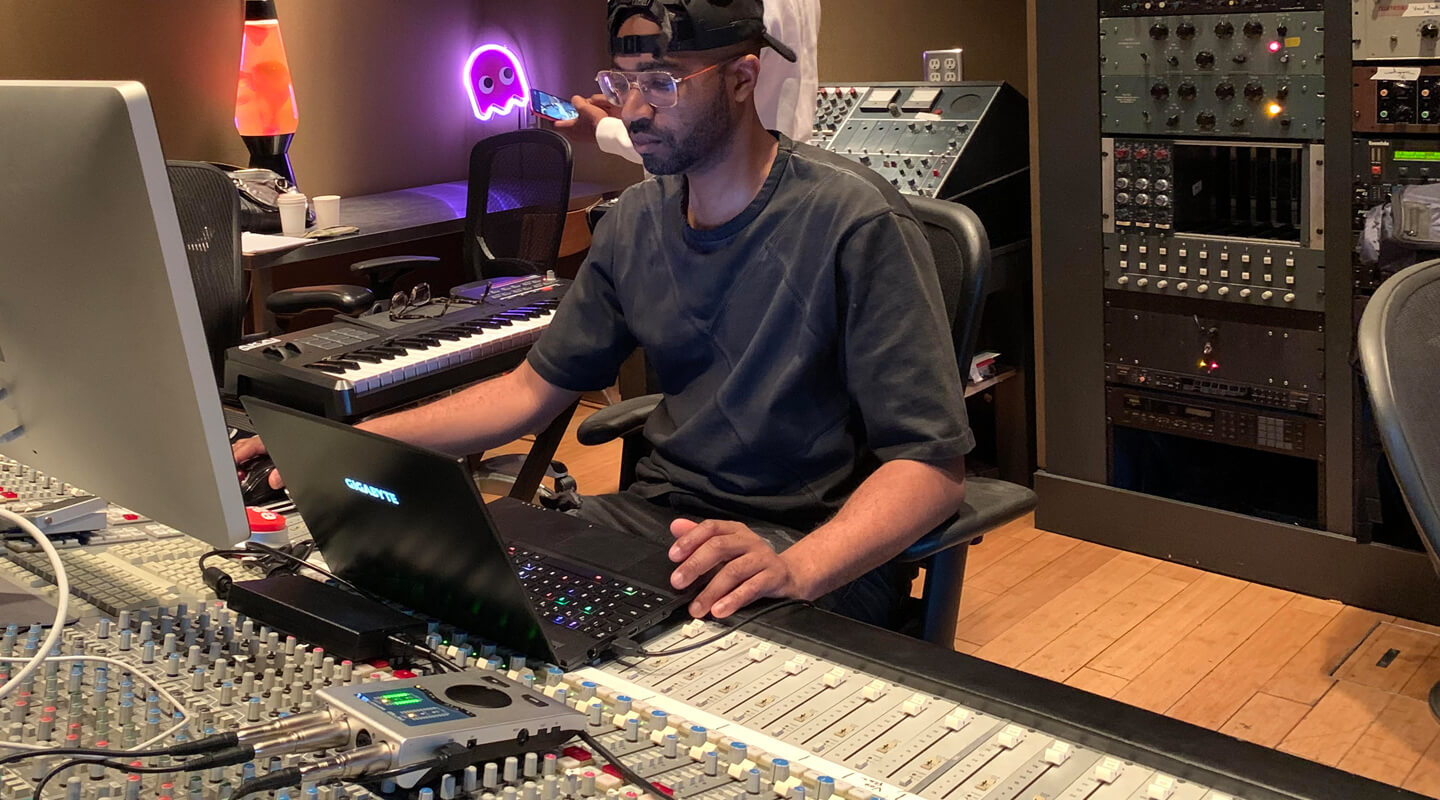Babyface Pro FS
24-Channel 192 kHz bus-powered professional USB 2.0 Audio Interface


Connectivity and Features

Connects to USB2 and USB-C (cable included). All features working fully bus-powered, even on legacy USB ports!
Go all-in. Get the best out!
Combining the best mobile MicPres, AD/DA, Headphone Amps,
Mac & Win Drivers and Low-Latency Performance in a single USB-powered interface.

Babyface Pro FS - Pristine Sound Quality. Ultra-Portable Design. Unparalleled Innovation.
Record exactly what you hear
Audio signals captured by the Babyface Pro FS are passed in their entirety, nothing added, nothing taken. The end result: reference quality recordings that rise above the competition, and that you’ll be proud to call your own.
Both headphone outputs provide the High Power / Zero Noise design of the industry-leading, reference converter ADI-2 Pro FS now. Lowest Noise achieved!
Industry-leading headphone preamp technology guarantees lowest-noise and ultra-low latency, outperforming even well regarded stand-alone headphone amplifiers, no matter what type of headphone or IEMs are used!
The THD of both parallel phones outputs improve by 10 dB. The 3.5 mm TRS phones output power rises to 90 mW. THD of both phones outputs improved by up to 10 dB. Finally the output impedance of 3.5 mm TRS was lowered from 2 Ohms to 0.1 Ohms.
Connect your favorite Gear.
Best-in-Class Mic & Line Inputs
For the main I/O RME have designed a XLR socket, which integrates seamlessly into the housing and saves space.Two digitally controlled preamps provide individually switchable 48V phantom power. These circuits feature a gain range of 76 dB, adjustable in steps of 1 dB, including a relay-driven PAD, resulting in exceptional EIN (Equivalent Input Noise) performance as well as line overload protection, and enough gain for even the lowest level microphones.
Babyface Pro’s incredibly efficient design almost never requires an external power supply – it’s perfectly stable on USB 3 bus power, and also most USB 2 ports, with no degradation in any technical specification. This makes it perfect for mobile recording, even with a pair of your favourite condenser microphones.
The comprehensive feature set continues with an optical TOSLINK I/O; use as either an ADAT port with SMUX support or SPDIF for sessions up to 192 kHz. In combination with an external ADAT converter, the Babyface Pro fully supports 12 analog inputs as well as 12 outputs, making it ideal for both live and studio multi-track applications. You can plug any instrument, line or high impedance, into Babyface Pro’s jack inputs 3 & 4. Record your guitar on the go, with no additional hardware required.
MIDI I/O via an included breakout cable completes the package.
Industry Reviews

More Outstanding Features
SteadyClock FS - Reference class Digital Clocking
Excellent performance in all clock modes and High Quality Analog Conversion to hear your mix as it is, with lowest jitter and highest jitter immunity.
TotalMix FX - Mixing/Routing with superior features for Studio and Live Work
Since 2001 TotalMix added unlimited routing and mixing to RME‘s audio interfaces. Its unique capability to create as many independent submixes as output channels available turned it into the most flexible and powerful mixer of its kind.
DigiCheck - The Secret Weapon of High Resolution Audio Measurements
RME Audio interfaces not only provide you with a professional digital audio interface, but also with a free available software tool: DigiCheck, for metering, testing, measuring and analyzing digital audio streams.
RME USB - Transport audio with lowest latency and industry leading stability
Use your RME audio interface on Mac and PC with reliable, stable, and regularly updated drivers for our products. RME Audio develops its own interface core, it’s not dependent on 3rd parties for upgrades, modifications or bug fixes, so customers can use latest operating systems without interruption or delay."
Specs
Babyface Pro FS
Analog
AD, Microphone/Line 1-2
- Input: XLR, electronically balanced
- Input impedance balanced: 2 kOhm, 5.2 kOhm with PAD
- Input impedance unbalanced: 1 kOhm, 2.6 kOhm with PAD
- Signal to Noise ratio (SNR): 113,7 dB RMS unweighted, 117 dBA
- Frequency response @ 44.1 kHz, -0.1 dB: 18 Hz – 20.8 kHz
- Frequency response @ 96 kHz, -0.5 dB: 7 Hz – 45.8 kHz
- Frequency response @ 192 kHz, -1 dB: 5 Hz – 88 kHz
- With PAD active : -0.1 dB 8 Hz, -0.5 dB < 4 Hz, -1 dB < 3 Hz
- THD: < -112 dB, < 0.00024 %
- THD+N: < -108 dB, < 0.00035 %
- THD @ 30 dB Gain: < -115 dB, < 0.00016 %
- THD+N @ 30 dB Gain: < -100 dB, < 0.001 %
- Channel separation: > 110 dB
- Gain range: -11 dB up to +65 dB
- Maximum input level XLR, Gain 0 dB: +8 dBu, PAD +19 dBu
- Maximum input level XLR, Gain 65 dB: -57 dBu, PAD -46 dBu
AD, Line/Instrument In 3-4
As Microphone/Line 1-2, but:
- Input: 6.3 mm TS jack, unbalanced
- Input impedance: 1 MOhm
- Signal to Noise ratio (SNR): 116 dB RMS unweighted, 120 dBA
- Frequency response @ 44.1 kHz, -0.1 dB: 5 Hz – 20.8 kHz
- Frequency response @ 96 kHz, -0.5 dB: < 3 Hz – 45.8 kHz
- Frequency response @ 192 kHz, -1 dB: < 2 Hz – 92 kHz
- Maximum input level @+4 dBu, Gain 0 dB: +13 dBu
- Maximum input level @-10 dBV, Gain 9 dB: -5 dBu
DA, Line Out 1-2
- Dynamic range (DR): 115 dB RMS unweighted, 118 dBA
- Frequency response @ 44.1 kHz, -0.5 dB: 0 Hz – 20.8 kHz
- Frequency response @ 96 kHz, -0.5 dB: 0 Hz – 45 kHz
- Frequency response @ 192 kHz, -1 dB: 0 Hz - 89 kHz
- THD: - 106 dB, 0.0005 %
- THD+N: -102 dB, 0.0008 %
- Channel separation: > 110 dB
- Output: XLR balanced
- Output impedance: 300 Ohm balanced, 150 Ohm unbalanced
- Output level @ 0 dBFS: Balanced +19 / +4 dBu, unbalanced +13 / -2 dBu
- DC @ 0 dBFS: 6.35mm 4.8 V, 3.5mm 2.4 V, XLR bal. 9.6 V
DA, Phones 3/4
AS DA Line Out, but:
- Output: 6.3 mm TRS jack, unbalanced
- Output impedance: 10 Ohm
- Output level at 0 dBFS, 1 kOhm load: +13 dBu
- Max power @ 0.1% THD: 60 mW
- Signal to Noise ratio (SNR): 114.8 dB RMS unweighted, 118 dBA
- Noise level: -101.8 dBu
- Output: 3.5 mm TRS jack, unbalanced
- Output impedance: 0.1 Ohm
- Output level at 0 dBFS, 1 kOhm load: +7 dBu
- Max power @ 0.1% THD: 90 mW
- Signal to Noise ratio (SNR): 114 dB RMS unweighted, 117 dBA
- Noise level: -107 dBu
MIDI
- 1 x MIDI I/O via breakout cable with 2 x 5-pin DIN jacks
- Galvanically isolated by optocoupled input
- Hi-speed mode: Jitter and response time typically below 1 ms
- Separate 128 byte FIFOs for input and output 25.3
Digital
- Clocks: Internal, ADAT In, SPDIF In
- Jitter suppression of external clocks: > 50 dB (2.4 kHz)
- Effective clock jitter influence on AD and DA conversion: near zero
- PLL ensures zero dropout, even at more than 100 ns jitter
- Digital Bitclock PLL for trouble-free varispeed ADAT operation
- Supported sample rates: 28 kHz up to 200 kHz
Digital Inputs
ADAT Optical
- 1 x TOSLINK
- Standard: 8 channels 24 bit, up to 48 kHz
- Double Speed (S/MUX): 4 channels 24 bit 96 kHz
- Quad Speed (S/MUX4) : 2 channels 24 bit 192 kHz
- Bitclock PLL ensures perfect synchronisation even in varispeed operation
- Lock Range: 31.5 kHz – 50 kHz
- Jitter suppression: > 50 dB (2.4 kHz)
SPDIF optical
- 1 x optical, according to IEC 60958
- Accepts Consumer and Professional format
- Lock Range: 27 kHz – 200 kHz
- Jitter suppression: > 50 dB (2.4 kHz)
Digital Outputs
ADAT optical
- 1 x TOSLINK
- Standard: 8 channels 24 bit, up to 48 kHz
- Double Speed (S/MUX): 4 channels 24 bit 96 kHz
- Quad Speed (S/MUX4) : 2 channels 24 bit 192 kHz
SPDIF optical
- 1 x optical, according to IEC 60958
- Format Consumer (SPDIF) according to IEC 60958
- Sample rate 28 kHz up to 200 kHz
General
- Power supply: USB bus power or external power supply
- Idle power consumption: 2.8 Watts
- Typical power consumption: 3.7 Watts
- Max. power consumption: 5.4 Watts
- Current at 5 V bus power operation: 700 mA (3.7 Watts)
- Current at 12 V external power: 313 mA (3.7 Watts)
- Dimensions (WxHxD): 108 x 35 x 181 mm (4.25" x 1.4" x 7.1")
- Weight: 680 g ( 1.5 lbs)
- Temperature range: +5° up to +50° Celsius (41° F up to 122°F)
- Relative humidity: < 75%, non condensing
All specifications are subject to change without notice.
Manuals
Babyface Pro FS
Latest manual for Babyface Pro, version 1.2, 01/2019
Latest manual for Babyface Pro, version 1.5, 09/2020




